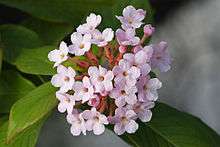Luculia
| Luculia | |
|---|---|
 | |
| Luculia gratissima | |
| Scientific classification | |
| Kingdom: | Plantae |
| Clade: | Angiosperms |
| Clade: | Eudicots |
| Clade: | Asterids |
| Order: | Gentianales |
| Family: | Rubiaceae |
| Tribe: | Luculieae |
| Genus: | Luculia Sweet |
| Type species | |
| Luculia gratissima Sweet | |
Luculia is a genus of flowering plants in the Rubiaceae family. It was described by Robert Sweet in 1826 and is currently found from the Himalayas to southern China.[1] The species are shrubs or small trees, generally found on upland scrub and woodland or forest margins. They have large leaves from 20-35cm with prominent veins carried in opposite pairs. The inflorescence is a terminal umbel or corymb of tubular/open ended white, pink or creamy flowers with 5 spreading petals. It may be from 10-20cm, depending on the species.[2]
Species
- Luculia grandifolia Ghose
- Luculia gratissima (Wall.) Sweet
- Luculia pinceana Hook.
- Luculia yunnanensis S.Y.Hu
References
- ↑ "Luculia in the World Checklist of Rubiaceae". Retrieved July 2012. Check date values in:
|access-date=(help) - ↑ Christopher Brickell, The RHS Encyclopedia of Garden Plants, Dorling Kindersley, London, 1996, p634. ISBN 0-7513-0436-0
External links
This article is issued from Wikipedia - version of the 11/10/2016. The text is available under the Creative Commons Attribution/Share Alike but additional terms may apply for the media files.